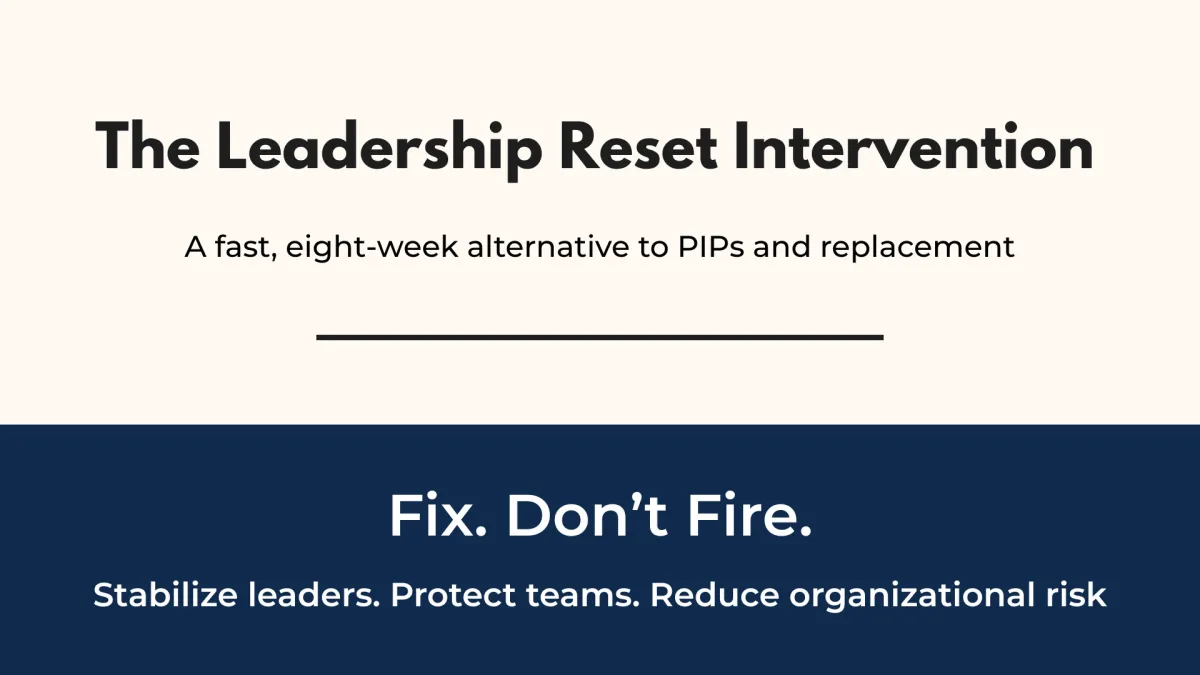This month's free training:
3 MISTAKES THAT KEEP LEADERS OVERLOOKED
From invisible to strategically significant in 30 minutes.

Confident Leadership.
Aligned Teams.
Sustainable Growth.
Leadership development, executive coaching, and confidential strategic support for leaders ready to align, decide, and move forward.
Conversation is easy. Clarity takes work.

OUR RESULTS
We track client progress ensuring results are unmistakable and quantifiable.

Self-reported by participants of our 1:1 and group coaching programs based on their before and after Leadership Index results.
HOW WE HELP
Whether you need to align your team, guide your board, or grow as a leader, each solution is designed to deliver focused progress without overwhelm or unnecessary extras.
An 8 -week strategic intervention for healthcare and human-centered organizations who want to support struggling leaders to stabilize leadership performance, rebuild trust, and restore organizational confidence.
This 90-day, strategy-first executive coaching engagement is designed for high-performing leaders who want to stop reacting, start leading with intention, and see visible results every week.
Not sure where to begin?
Start with a conversation.
WHAT COACHING CLIENTS SAY

"Leading my business
with clarity"
I went from a limited pipeline to signed deals and a clear strategic direction. I’m no longer in survival mode - I’m leading my business with focus and relief for the future.


"Confidence and visibility
transformed my career"
Asia helped me face fears I’d avoided for years - from public speaking to building my personal brand. She tailored the process to my goals, helping me grow in confidence and visibility as an executive.


"Immediate trust
and insight"
Within minutes of our consultation, I knew Asia was the coach for me. Her warmth, insight, and professionalism made it clear I could trust her guidance.


"A complete career
transformation"
I stepped out of my comfort zone, built relationships I never would have before, and landed a senior role I love. The intentional focus completely shifted my confidence.


"Hearing my own
voice clearly"
Asia’s coaching changed how I hear myself. She doesn’t hand you answers - she helps you find your own voice and clarity. That shifted how I lead and make decisions.


"Redefined success
on my own terms"
Within months, I went from being unsure and stuck to landing the opportunity I really wanted. Asia helped me define success and make it real.

SIGN UP FOR OUR FREE WEEKLY NEWSLETTER

How you lead matters.
Sign up for our Skip Level Strategies newsletter, where every Sunday you'll start your week with a practical 5-minute perspective shift and action to bring your leadership, decision-making, and communication to the next level.
PAST NEWSLETTERS

Issue 60: How to lead your team when everything feels uncertain
Issue 60: How to lead your team when everything feels uncertain
"You may not control all the events that happen to you, but you can decide not to be reduced by them."
- Maya Angelou
This issue is coming to you a little late this week as I continue to take in the job market shifts day to day. The headlines aren’t subtle-federal layoffs are here and more are coming, and instability is spreading across multiple sectors. Even if your team hasn’t been directly impacted yet, people are feeling the weight of uncertainty.
And when people feel uncertain, they disengage. Productivity drops. Team members start looking out for themselves instead of operating as a unit.
As a leader, your job isn’t to have all the answers-it’s to provide clarity, direction, and stability in the middle of the unknown. Here’s how to do that right now.
Step 1: Acknowledge the uncertainty
Silence makes things worse. If your team senses instability but hears nothing from you, they’ll assume the worst.
You don’t need all the answers-just transparency. Saying “I don’t know yet, but here’s what I do know” builds more trust than avoidance.
Give people a role in shaping the future. Ask: “What’s in our control right now? What can we focus on to stay strong as a team?”
Step 2: Keep people focused on what actually matters
Separate noise from real priorities. When layoffs loom, some people freeze, while others panic and waste time on distractions. Refocus them on high-value work.
Make sure team meetings reinforce clarity, not chaos. Instead of letting uncertainty drive conversations, ask:
“What’s our top priority this week?”
“What do we need to keep delivering at a high level?”
If priorities shift, explain why. The more people understand how their work connects to larger goals, the more engaged they’ll stay.
Step 3: Protect morale, even in difficult moments
Don’t dismiss emotions-address them. If people are anxious, overwhelmed, or frustrated, give them space to express that.
Reinforce your team’s strengths. Even when times are tough, remind them: “We know how to solve problems. We know how to adapt. That hasn’t changed.”
Encourage people to take small, proactive steps. Ask: “What’s one thing you can do this week to stay in control of your work and career?”
This is where real leadership happens.
It’s easy to lead when things are stable. But when uncertainty takes over, your presence, clarity, and ability to keep your team engaged will define your leadership.
If you’re navigating uncertainty, my 6-week executive coaching beta is open for a limited time. I’m working with leaders to strengthen their leadership, stabilize their teams, and reposition themselves for what’s next.
Reach out to see if I still have spots available.
Go out there and lead,
Asia
P.S. Next week, we’ll talk about how to maintain influence-even when you don’t have decision-making power.
What’s one way you’re keeping your team steady right now? Reply and let me know-I’d love to hear.
Bridgewell LLC - Strategy and Leadership


























